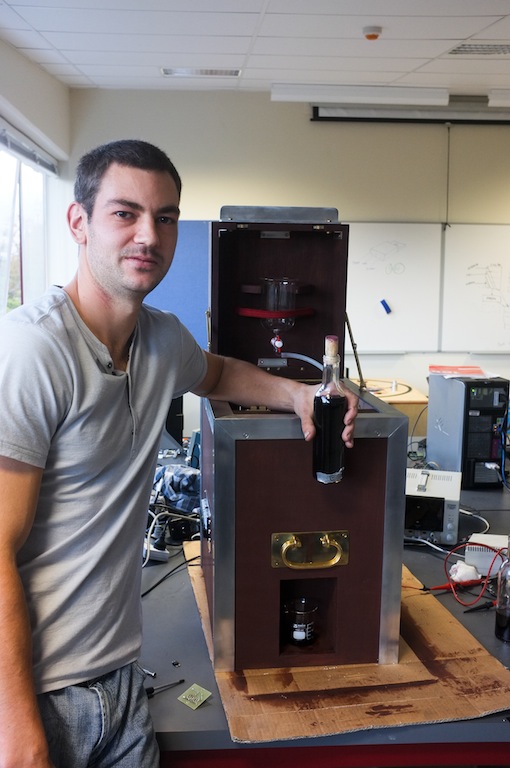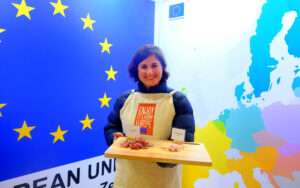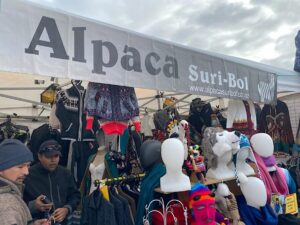Waikato inventor matures wine in 3 minutes
Waikato University researchers meant to disprove a paper from China claiming wine could be matured in three minutes and, for once, they were happy to be wrong.
A wine glass stands in place of a beaker. Professors pause to smell the aroma as a measure of results. There are bottles of wine, rum and scotch alongside electronic machines.
This is not a scenario from science fiction. Instead, it is Monday afternoon in an engineering lab at Waikato University.
The experiment under scrutiny, though, does sound like something from science fiction. It involves wine and a miracle, of sorts.
Mark Benseman, 25, an honours graduate in electronic engineering, has developed a maturation machine that makes wine age in three minutes.

Today, the machine is being tested to go on display at Fieldays. Once the test is done, the wine glass is passed around the room and like wine experts, members of the group nod in appreciation.
A few years ago, a scientific paper in China claimed wine could be aged in three minutes flat by exposing it to an electric field.
Prof Jonathan Scott, of Waikato University, doubted the veracity of the claims.
“We thought, ha ha ha snake oil,” Prof Scott says.
In a bid to disprove the theory, Benseman was assigned a student project – but the results were unexpected.
“It bloody well worked. I mean we just stood staring at each other, it was such a shock,” says Prof Scott.
It was a ‘grin moment’ for Mark Benseman as well, who was doing the experiment as a part of summer research scholarship. The project received notice back then, with TV and news coverage. Then it disappeared from the radar.
“We thought `gee that was exciting, someone ought to do something about it’, but we felt that someone probably should be a vineyard, not a university, so we didn’t do anything about it,” Prof Scott said.
Now the machine is coming to Fieldays and will be showcased on the University of Waikato Premier Feature stand. The University of Waikato is a strategic partner at Fieldays and has two stands this year, the Premier Feature stand and a marquee which has other interactive exhibits and hosts the seminar series.
But how does a simple box-like apparatus attached with few wires do this seemingly miraculous thing?
Prof Scott explains, his arms moving in the air simulating current and molecules. He states Maxwell’s equations. This does not help.
Benseman says there is a positive and a negative plate, and between them an electric field oscillates at a set frequency.
“Our theory is that vibrating the molecules in the wine and doing it at just the right frequency seems to speed up the process at which they interact with each other and that simulates ageing,” he says.
It has been a long journey for the maturation machine and its inventor.
Mark Benseman first got interested in the project when he saw an opportunity to work on wine as part of summer research scholarship.
“I worked at a winery on the Kapiti coast since I was 12. I have an interest in wine to start with, so I saw this summer research come up and thought I’d do that,” he says.
Benseman began by building a prototype and the first wine he used for testing was a mandarin wine made by one of his friends.
The new robust version of the machine was built in three weeks by Benseman and his friend Stephen Halliday, who drove six hours from their hometown Waikanae and worked for four days on the mechanical side of things.
“I told Stephen I’d mention his name,” Benseman says.
He says people take a lot of convincing as it seems too simple just to apply an electric field across some plates and get years’ worth of ageing.
Wine-making is very traditional and there is a reluctance to accept or test such a dramatic innovation.
“When the wine industry changed from cork-screws to cap-screws it took quite a few years of getting it done. This will take even longer,” Benseman says.
Prof Jonathan Scott agrees and says there is much work left to be done.
“It will take a lot of time to decide if it will do something useful. One liquid and a few frequencies and a few voltages – that is a year’s work.
“It took 2000 years to get wine right; giving them a whole new couple of degrees of freedom is not going to knock that over in a hurry.”
Mark Benseman, however, is done with waiting and wants to see commercial application of the machine.
“I want to see it make money. I am not particularly interested in writing papers about it.”




